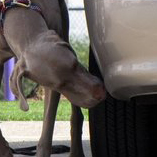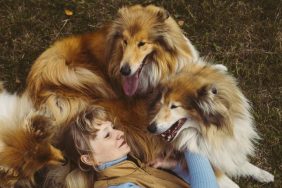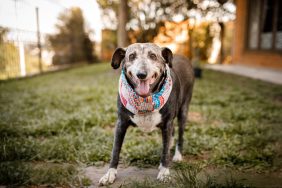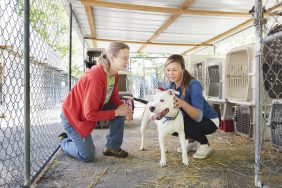I finally found the perfect sport for my dogs: Eating treats out of a box. To the uninitiated, that’s what the sport of nose work looks like at first glance.
The goal is for the dog to find a specific odor — birch, anise, or clove — in different environments and then to alert the handler to the find. The sport was founded in 2006 by California dog trainers Amy Herot, Ron Gaunt, and Jill-Marie O’Brien and held its first national trial this year.
For the first few classes, soft and stinky treats are placed in open boxes and the dogs are encouraged to find and eat them. That’s to get them accustomed to the idea of sniffing out something in a box. Most dogs pick it up almost immediately, and they get rewarded with more treats (or a favorite toy if they aren’t motivated by food) when they make their find.
The first six weeks of class are devoted to letting dogs practice finding treats and teaching owners the basics of the search: understanding how air flow and other factors affect scent, proper leash handling, and how to read the dog’s signals. Odor is usually introduced in the next six-week session, paired with treats in a box or other container. Searches start to become more difficult, with scent placed in small tins, high up, underneath furniture, or on vehicles. The dogs may be required to search multiple rooms or find multiple odors.
Once they have the basics down, teams can sign up for an odor recognition test, or ORT. If they pass, they can begin competing for nose work titles: NW1, NW2, NW3, and NW3 Elite. Harper, my Cavalier, and Gemma, my longhaired Chihuahuamix, are signed up for an NW1 trial in January.
The best thing about nose work is that all dogs can play, no matter what their age, breed, or physical limitations. The other dogs in our class include a Dachshund, a Boxer, a Pekingese, an Australian Shepherd, and a Pit Bull Terrier. Because of the praise, rewards, and lack of corrections during training, the activity is a great confidence-builder for dogs, says trainer Nicole Reusser, owner of Rock Solid K9 in Laguna Niguel, Calif.
“We have seen many low-confidence dogs who barely dared to enter the classroom perk up and pull to get to the search area in just a couple of lessons,” she says. “It is also a great sport for dogs who are reactive to other dogs. Only one dog at a time is allowed during the search. All other dogs relax in the car or other separate area in their crates.”
Dog and handler are a team, but the dog is the leader. He’s the one with the powerful nose, after all. That can be a challenge for some owners.
“People are so used to telling the dog what to do that they have a hard time letting the dog conduct the search,” says trainer Chris Busch of Lakewood, Calif.
It’s up to the handler to learn to read the dog’s cues and determine when he has successfully located the scent. When that happens, it’s not only rewarding for the dog, Busch says; it’s also enjoyable for the handler.
“The biggest benefit,” he says, “is the enjoyment of the hunt and then the find.”









